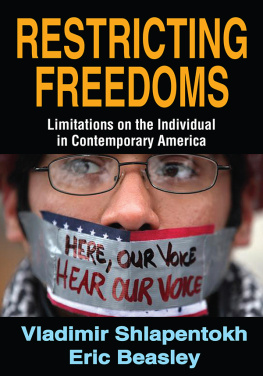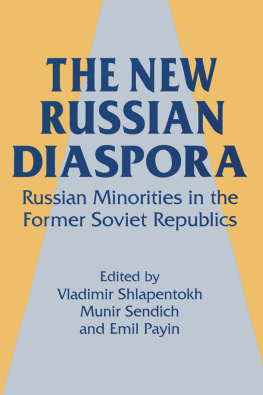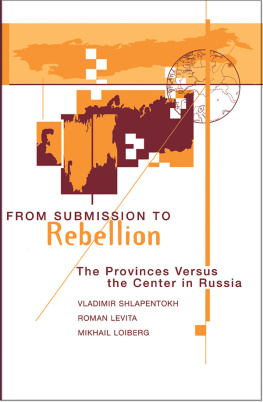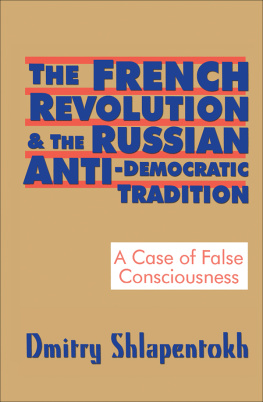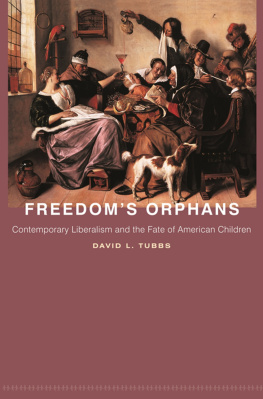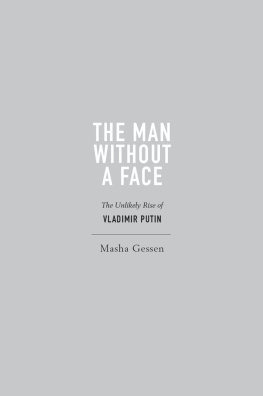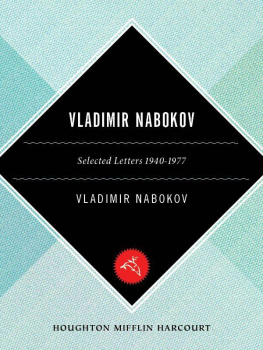First published 2013 by Transaction Publishers
Published 2017 by Routledge
2 Park Square, Milton Park, Abingdon, Oxon OX14 4RN
711 Third Avenue, New York, NY 10017, USA
Routledge is an imprint of the Taylor & Francis Group, an informa business
Copyright #x00A9; 2013 by Taylor & Francis.
All rights reserved. No part of this book may be reprinted or reproduced or utilised in any form or by any electronic, mechanical, or other means, now known or hereafter invented, including photocopying and recording, or in any information storage or retrieval system, without permission in writing from the publishers.
Notice:
Product or corporate names may be trademarks or registered trademarks, and are used only for identification and explanation without intent to infringe.
Library of Congress Catalog Number: 2012016758
Library of Congress Cataloging-in-Publication Data
Restricting freedoms: limitations on the individual in contemporary America / Vladimir Shlapentokh and Eric Beasley.
p. cm.
1. Individualism--United States. 2. Freedom. I. Shlapentokh, Vladimir.
II. Beasley, Eric.
JC599.U5R42 2012
323.490973--dc23
2012016758
ISBN 13: 978-1-4128-4972-2 (hbk)
For many readers, especially those who are patriotic and smitten with their country, the subtitle Limitations on the Individual in Contemporary America will seem downright weird. It is difficult for most Americans to imagine that they, like Gulliver waking up in Lilliput to find himself bound by a lattice of slender ligatures, are constrained by ordinances and rules that are so far-reaching that they can mandate that a person must use an obligatory color when painting his or her home or specify how a person can treat a cat. Restrictions are generally expressed in two ways: (1) direct bans on taking certain actions (e.g., a ban stipulating that you cannot cross the street on a red light), and (2) semi-structured rules that allow some discretion within set parameters (e.g., a rule that stipulates that you can send your children to any given school in a school district as long as you are a permanent resident in the district).
Contrary to the intentions of the restrictive circumstances in which Gulliver finds himself in Lilliput, American laws and rules are aimed at providing a structure that will generally, although not necessarily, benefit individuals as well as the country as a whole. In actuality, however, while some Americans undoubtedly benefit from specific rules and regulations, others end up suffering from such restrictions. Indeed, the tendency for those in power to create rules and regulations that benefit themselves, often at the expense of others, is one of the major points of social scientists who align themselves with the conflict perspective, and a great deal of convincing research has been carried out in support of this notion. Still, the summative societal benefit accrued from the existence of rules is hard to deny. To illustrate, consider what would become of traffic if our roads had no signs, lights, or lines to guide motorists. Even though it is easy to see how rules and restrictions hold together the fabric of societies by providing, on average, a more pleasant social world for people to inhabit than could exist given a moratorium on rules and restrictions altogether, it is difficult for many Americansmany of whom see any restriction as a direct challenge to American democracy and freedomto recognize this. After all, this is the land of the free, and mantras proclaiming freedom as a central tenet of the American experience are neither few nor far between.
The idea that American society should be based on people enjoying unadulterated freedom in all spheres of life is unrealistic and simplistic. Somewhat ironically, even Libertarian views point to this; they recognize, albeit reluctantly, the necessity of some governmental interventions aimed at promoting the public good (e.g., control over the quality of water). Still, in general, Libertarians fear the superiority of the free market being hampered by nanny government regulations addressing other livelihood concerns (e.g., regulations on food quality and medical services), although there is certainly a considerable amount of variations in the beliefs among self-identified Libertarians about the degree to which free-market principles should trump forms of top-down regulation.
In this book, we pragmatically define freedom as the ability of people to choose one of many alternatives available in a certain sphere of life. In elucidating this concept of freedom, it is important for us to note the occasional occurrence of the somewhat paradoxical phenomenon that occurs when freedoms can be expanded by restrictions because the restrictions provide people with more alternatives. Thus, being free or restricted is not an all-or-nothing proposition but rather a question of degrees. Consider many of the most heralded constitutional amendments: the First Amendment, which promised freedom of religion, press, and expression; the Second Amendment, which gave Americans the right to bear arms; the Thirteenth Amendment, which made slavery illegal; the Fourteenth Amendment which gave these former slaves and others the right to be citizens; and the Nineteenth Amendment, which allowed women to vote. All of these amendments restricted the intentions of certain elements within society while simultaneously providing more freedom to many individuals by expanding the number of alternatives available to them.
Other amendments expanded the freedoms of everyday people in a slightly different fashion. These laws increased the peoples choices by restricting the governments legal authority to interfere with the freedoms of private citizens. For instance, the Fourth Amendment officially protects citizens from unreasonable searches. And the Fifth Amendment protects the property of citizens from arbitrary government seizures without just compensation.
This history surrounding the expansion of alternatives available to people in their everyday lives has been one of the magisterial developments defining the American way of life. Indeed, no other country in the world has had such a cult-like fascination with freedom as the Yankees, a devotion that can be traced all the way back to the American Revolution. Today, freedom is so closely associated with the United States that, despite the rabid anti-Americanism that has spread across the globe, most people still view America as the ultimate symbol of freedom (Shlapentokh, Shiraev, and Woods 2005). This is one of the reasons why the desire to immigrate to the United States from almost anywhere in the world has not waned for more than a century (Prescott 2008; Pile 2005).
The rise of fascism in the early Twentieth century and its ultimate defeat in World War II helped to secure freedoms position as a central principle that societies strived for in the latter part of the century. Even many authoritarian regimes have had to reluctantly recognize peoples desire for freedom in the late twentieth century. Contrary to the absolute monarchies that ruled in the nineteenth and early twentieth centuries, almost none of the despotic and cruel post-World War II regimes dared to openly challenge freedoms within society. Soviet ideology, for example, paid tribute to freedom by asserting that Soviet people enjoyed real freedom, in comparison with the denizens of capitalist societies and their formal freedoms that were incompatible with social equality.


